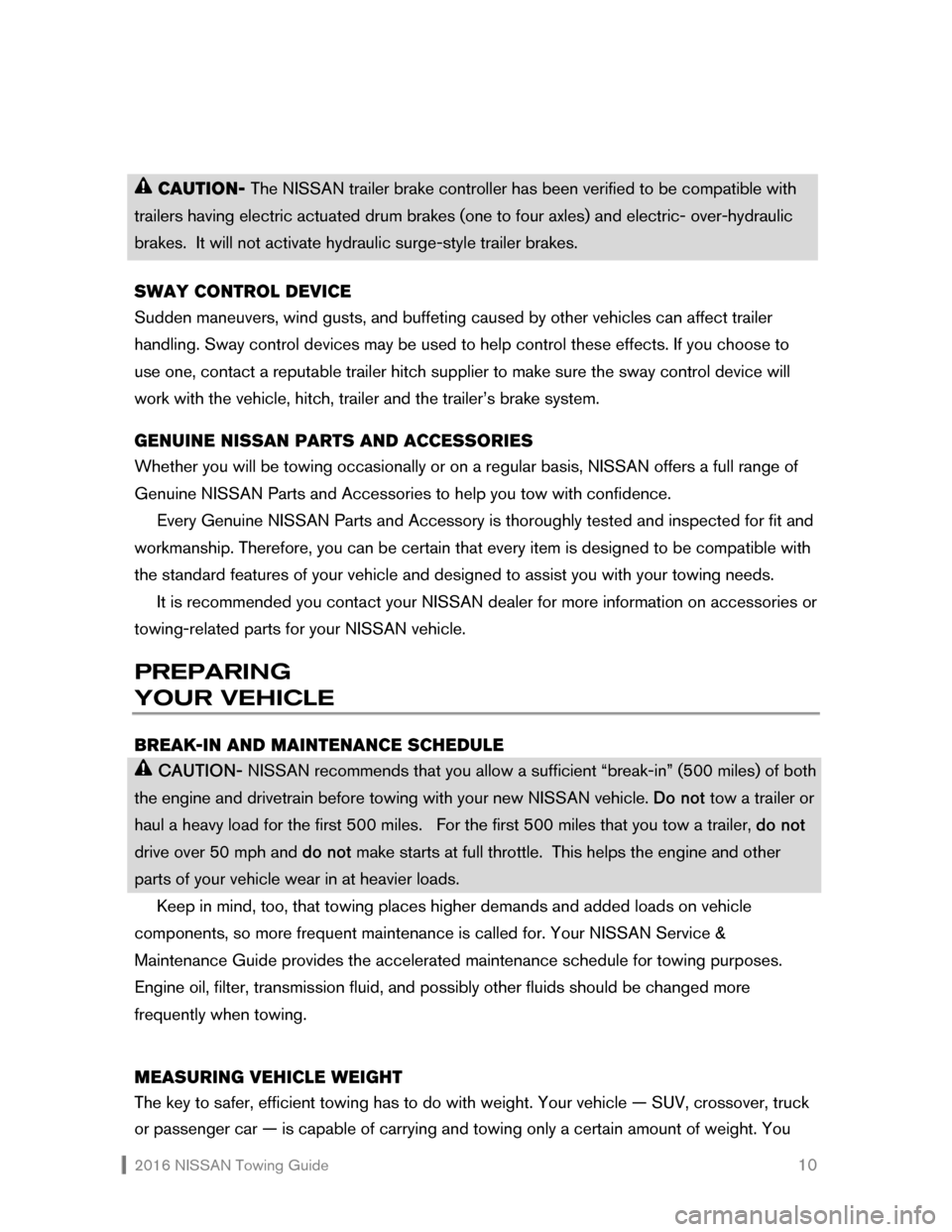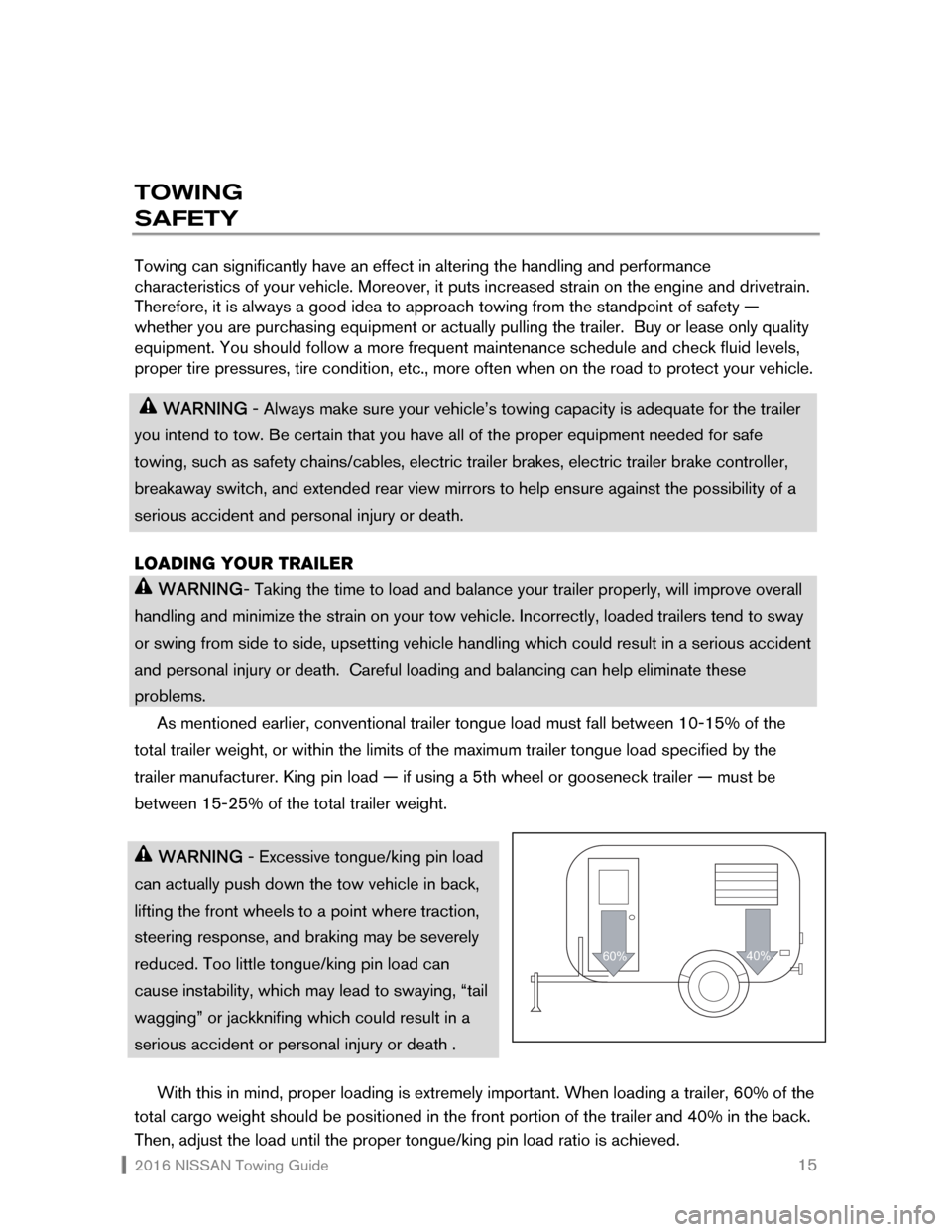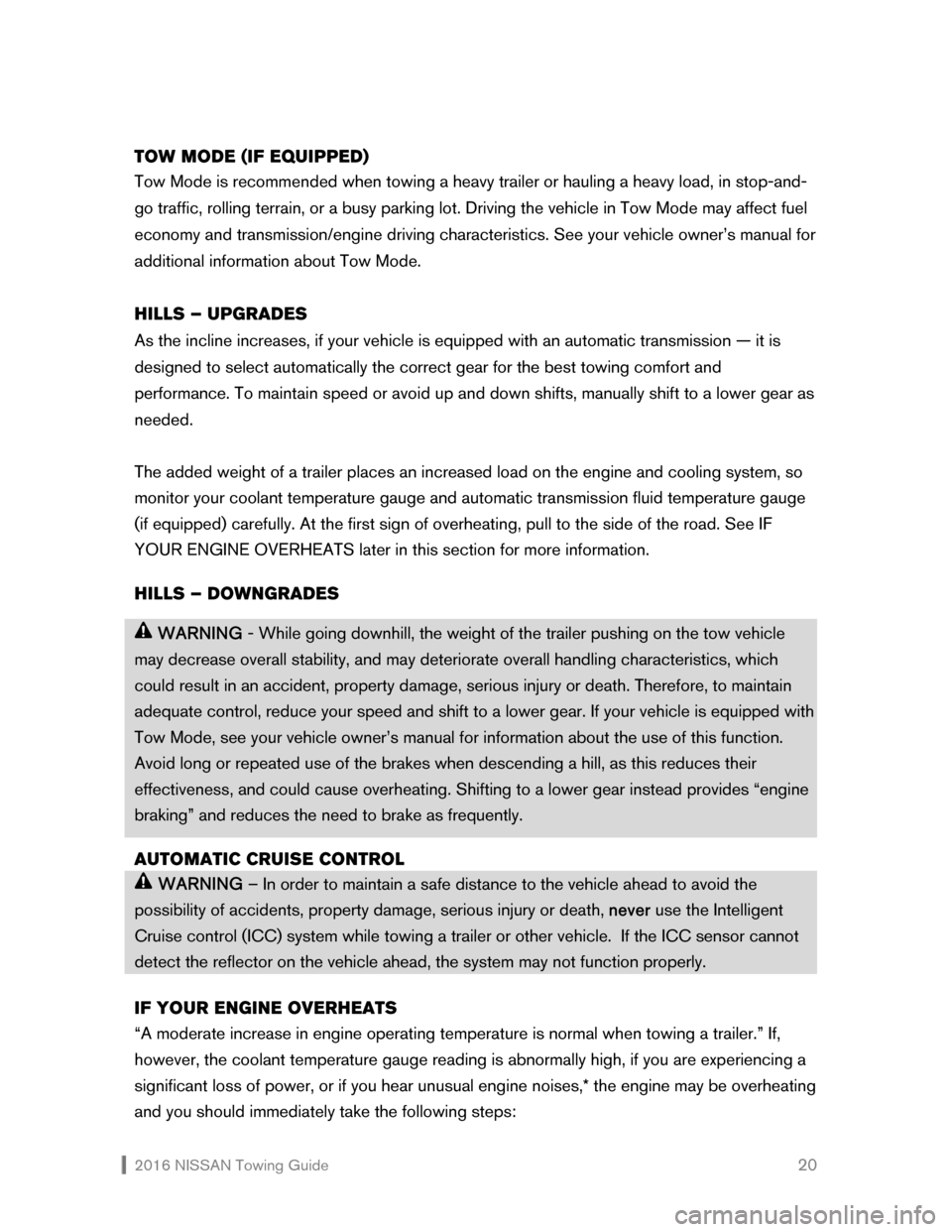2016 NISSAN ROGUE brake fluid
[x] Cancel search: brake fluidPage 11 of 27

2016 NISSAN Towing Guide 10
CAUTION- The NISSAN trailer brake controller has been verified to be compatible with
trailers having electric actuated drum brakes (one to four axles) and electric- over-hydraulic
brakes. It will not activate hydraulic surge-style trailer brakes.
SWAY CONTROL DEVICE
Sudden maneuvers, wind gusts, and buffeting caused by other vehicles can affect trailer
handling. Sway control devices may be used to help control these effects. If you choose to
use one, contact a reputable trailer hitch supplier to make sure the sway control device will
work with the vehicle, hitch, trailer and the trailer’s brake system.
GENUINE NISSAN PARTS AND ACCESSORIES
Whether you will be towing occasionally or on a regular basis, NISSAN offers a full range of
Genuine NISSAN Parts and Accessories to help you tow with confidence.
Every Genuine NISSAN Parts and Accessory is thoroughly tested and inspected for fit and
workmanship. Therefore, you can be certain that every item is designed to be compatible with
the standard features of your vehicle and designed to assist you with your towing needs.
It is recommended you contact your NISSAN dealer for more information on accessories or
towing-related parts for your NISSAN vehicle.
PREPARING
YOUR VEHICLE
BREAK-IN AND MAINTENANCE SCHEDULE
CAUTION- NISSAN recommends that you allow a sufficient “break-in” (500 miles) of both
the engine and drivetrain before towing with your new NISSAN vehicle. Do not tow a trailer or
haul a heavy load for the first 500 miles. For the first 500 miles that you tow a trailer, do not
drive over 50 mph and do not make starts at full throttle. This helps the engine and other
parts of your vehicle wear in at heavier loads.
Keep in mind, too, that towing places higher demands and added loads on vehicle
components, so more frequent maintenance is called for. Your NISSAN Service &
Maintenance Guide provides the accelerated maintenance schedule for towing purposes.
Engine oil, filter, transmission fluid, and possibly other fluids should be changed more
frequently when towing.
MEASURING VEHICLE WEIGHT
The key to safer, efficient towing has to do with weight. Your vehicle — SUV, crossover, truck
or passenger car — is capable of carrying and towing only a certain amount of weight. You
Page 16 of 27

2016 NISSAN Towing Guide 15
TOWING
SAFETY
Towing can significantly have an effect in altering the handling and performance
characteristics of your vehicle. Moreover, it puts increased strain on the engine and drivetrain.
Therefore, it is always a good idea to approach towing from the standpoint of safety —
whether you are purchasing equipment or actually pulling the trailer. Buy or lease only quality
equipment. You should follow a more frequent maintenance schedule and check fluid levels,
proper tire pressures, tire condition, etc., more often when on the road to protect your vehicle.
WARNING - Always make sure your vehicle’s towing capacity is adequate for the trailer
you intend to tow. Be certain that you have all of the proper equipment needed for safe
towing, such as safety chains/cables, electric trailer brakes, electric trailer brake controller,
breakaway switch, and extended rear view mirrors to help ensure against the possibility of a
serious accident and personal injury or death.
LOADING YOUR TRAILER
WARNING- Taking the time to load and balance your trailer properly, will improve overall
handling and minimize the strain on your tow vehicle. Incorrectly, loaded trailers tend to sway
or swing from side to side, upsetting vehicle handling which could result in a serious accident
and personal injury or death. Careful loading and balancing can help eliminate these
problems.
As mentioned earlier, conventional trailer tongue load must fall between 10-15% of the
total trailer weight, or within the limits of the maximum trailer tongue load specified by the
trailer manufacturer. King pin load — if using a 5th wheel or gooseneck trailer — must be
between 15-25% of the total trailer weight.
WARNING - Excessive tongue/king pin load
can actually push down the tow vehicle in back,
lifting the front wheels to a point where traction,
steering response, and braking may be severely
reduced. Too little tongue/king pin load can
cause instability, which may lead to swaying, “tail
wagging” or jackknifing which could result in a
serious accident or personal injury or death .
With this in mind, proper loading is extremely important. When loading a trailer, 60% of the
total cargo weight should be positioned in the front portion of the trailer and 40% in the back.
Then, adjust the load until the proper tongue/king pin load ratio is achieved.
60%40%
Page 21 of 27

2016 NISSAN Towing Guide 20
TOW MODE (IF EQUIPPED)
Tow Mode is recommended when towing a heavy trailer or hauling a heavy load, in stop-and-
go traffic, rolling terrain, or a busy parking lot. Driving the vehicle in Tow Mode may affect fuel
economy and transmission/engine driving characteristics. See your vehicle owner’s manual for
additional information about Tow Mode.
HILLS – UPGRADES
As the incline increases, if your vehicle is equipped with an automatic transmission — it is
designed to select automatically the correct gear for the best towing comfort and
performance. To maintain speed or avoid up and down shifts, manually shift to a lower gear as
needed.
The added weight of a trailer places an increased load on the engine and cooling system, so
monitor your coolant temperature gauge and automatic transmission fluid temperature gauge
(if equipped) carefully. At the first sign of overheating, pull to the side of the road. See IF
YOUR ENGINE OVERHEATS later in this section for more information.
HILLS – DOWNGRADES
WARNING - While going downhill, the weight of the trailer pushing on the tow vehicle
may decrease overall stability, and may deteriorate overall handling characteristics, which
could result in an accident, property damage, serious injury or death. Therefore, to maintain
adequate control, reduce your speed and shift to a lower gear. If your vehicle is equipped with
Tow Mode, see your vehicle owner’s manual for information about the use of this function.
Avoid long or repeated use of the brakes when descending a hill, as this reduces their
effectiveness, and could cause overheating. Shifting to a lower gear instead provides “engine
braking” and reduces the need to brake as frequently.
AUTOMATIC CRUISE CONTROL
WARNING – In order to maintain a safe distance to the vehicle ahead to avoid the
possibility of accidents, property damage, serious injury or death, never use the Intelligent
Cruise control (ICC) system while towing a trailer or other vehicle. If the ICC sensor cannot
detect the reflector on the vehicle ahead, the system may not function properly.
IF YOUR ENGINE OVERHEATS
“A moderate increase in engine operating temperature is normal when towing a trailer.” If,
however, the coolant temperature gauge reading is abnormally high, if you are experiencing a
significant loss of power, or if you hear unusual engine noises,* the engine may be overheating
and you should immediately take the following steps: